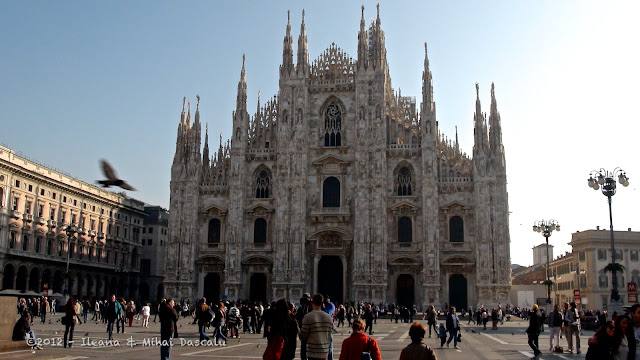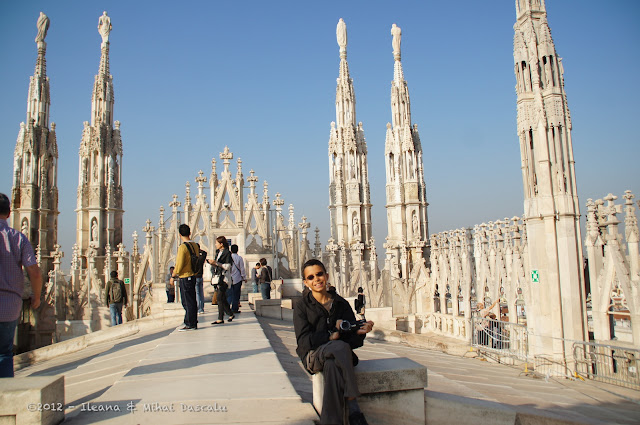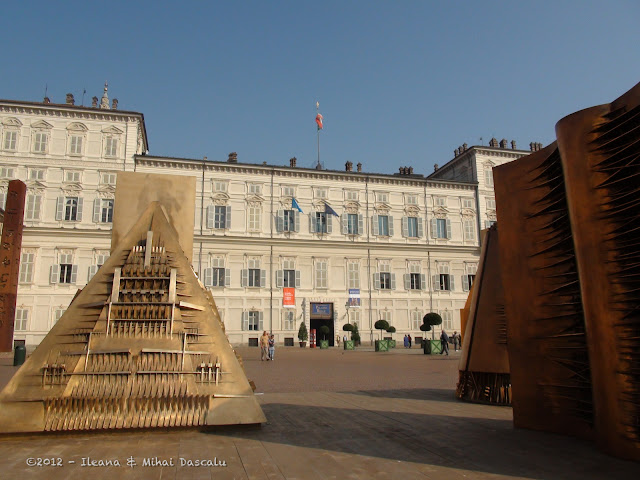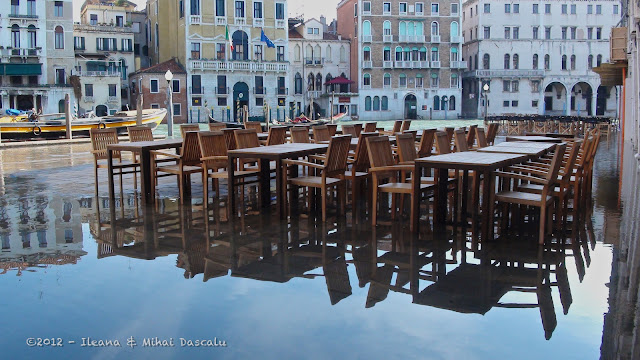We had a fantastic month in Greece, better than we could expect, we didn't want to move on, we had to. A few days before, we made our schedule. For a split second we questioned going to Venice, but we said it out loud and Maria ended the debate before it started: "Of course we go to Venice, I want to see it!" The other factor was transport from North to South, how to get to Napoli. The cheapest and fastest way was to fly on a particular day. We were left with eight nights in the North, to cover Milan, Torino, Florence and Venice.
I considered skipping Milano, but my mother said we really have to see the dome, the children, hearing its story, expressed some interest, and I was happy. I heard about it maybe forty years ago. I started to collect postcards as a child and all I had from Italy were with the Milan Dome. It seemed then to be the center of the world, the one and only site that I must see. Quite wrong, but I was a child.
 |
| The Dome in Milan, postcard type picture |
The dome started to be built in 1364 and finished at some point. Some say 1810, some 1965. There is still plenty of construction going on, inside and outside. The Milanese have an expression that means to work on a neverending task: "built the dome." It is the fourth largest church in the world, it is huge and the statistics are quite impressive. Thousands of statues outside and inside. All the dome is made of marble. All. Mostly pink, some white, some black. Even the roof is made of marble. We were glad we saw it but it was underwhelming, maybe even disappointing.
 |
| One side of the dome |
The dome started to be built by the dukes of Milan with the goal of impressing their Northern neighbors and flaunting the Pope. They wanted to make a statement that they also count. OK, they counted, but their primary message is arrogance, not any humility or love of God. I found the dome to be too big, too richly decorated, with not any clearly defined style. The first image we got when we emerged from the metro was of the side of the dome, scaffolding covered by an immense advertisement for the latest Samsung Galaxy. Come on. Such a bad taste and lack of decency. Maybe they will start putting ads on the robe of the priests like they do with football teams?
 |
| The other side of the dome with advertising |
We started to tour the exterior of the church. The children oh-ed and ah-ed for a couple of minutes, then completing their filial duties, they stopped in the front, pulled out their iPods and started to read, giving us time to take some pictures.
We entered. There were few people, it was early in the day. It was nice, but huge. Not huge in an impressive way, just huge. I was glad to see the floor designed as an open space, but disappointed to see it blocked by colossal paintings hanging in the view. We tried. We gave it a tour, got appropriately disgusted by the statue of a skinned-alive saint and admired a crane that was lifting a reporter to the ceiling. Then with the Dome museum closed for renovation the only thing left to see was the roof. Nobody had any interest in that, but since I was there, I wanted to do it and Ioan, generous as always, accepted to join me. To climb by stairs it was $9, to get a reduced ticket for Ioan we had to go two streets away at a special office. There were only a few hundreds steps and I was hoping to be rewarded, as the guidebooks say, by magnificent views over the city of Milan. Disappointed again. The view was obliterated by more and more statues, and the main statue at the top was covered by more scaffolding. We took the best pictures we could and rejoined the girls, who patiently waited in the church.


 |
| On the top |
The rest of Milan was a quick look at the Scala. It might be the most famous opera house in the world, but the exterior has nothing and we did not have time for a visit. We passed through the Victor Emanuel shopping gallery, 140 years old, it looked nice. We spun on the little bull's testicles, the fun activity one has to do in Milan and we were done.

Overall we spent 20 hours here, it was more than enough, the city didn't impress us. I don't think any of us plans to return here. Milan is the business and shopping center of Italy, a major city that hosts Leonardo da Vinci's Last Supper and several other artistic values. In any other country its attractions would be top rated but in Italy they hardly qualify for the second or third tier. The Last Supper is pretty much inaccessible. The entrance, at $10, must be reserved online and all the spots are taken up three months in advance. Many companies advertise organizing tours to see it, slapping another product, a tour or a booklet (!) and selling the tickets at 4-10 times the price. Even so, I couldn't find anything on the day we were here. There is a copy of the Last Supper, I would have settled for that, but the entrance at that museum was also outrageous.
We took the train to Torino. (I don't like the English Turin.) We had a nice apartment, renovated, in a 300 year old building, near the train station. We had two good nights and a great day, spent with friends, Maria Rosa and Federica, who played the role of guides. I liked Torino. The first capital of the united Italy (1861-1865), it's a city full of history, nice buildings, clean and quiet. The highlight for me was the little church that hosts the Holy Shroud. We saw the huge sarcophagus that holds it (it's locked inside and exposed only sporadically), the copy on the wall and we watched a short movie about it. Apparently it is a matter of scientific research and arduous debate if this was really the shroud that was used to bury Jesus. It seems that the piece of cloth is not old enough, the church rephrased the wording to something like "it belongs to a man that was crucified in a similar manner to Jesus Christ." I didn't care much about that, I was in the presence of the Holy Shroud and that was enough for me. It was good to visit a little normal beautiful church after the disappointment from the Milanese dome.
 |
| Old and new in Torino |
 |
| Mole Antonelliana, the tallest museum in the world |
 |
| End of our tour in Torino |
There are several palaces in Torino that are declared World Heritage Sites, grouped under the "Residences of the Royal House of Turin" we saw a couple on the outside, they look OK. What I liked most was the "portici", spacious covered side walks with nice looking store windows, 19th century architecture. I will miss that in the following days in Florence.
 |
| Castelo del Valentino, Torino |
 |
| Just one of hundreds of "portici", covered side walks |
We arrived there easily, by train, got to our rented apartment and were greeted by our host Camilla: "you are so lucky for such a fine weather". It will change dramatically in the following hours and the next three days we had only rain. Florence center, where we spent our time, is much like it was 500 years ago and there are no portici.
 |
| Unchanged for 500 years |
 |
| Firenze |
The rain water drips right on the side walk, there is hardly any cover. Florence is nice to walk around, but its treasures are all inside, in various museums. We got two Florence cards, a $65 three-day pass that allows unlimited transportation and one visit each to 33 museums. With the kids on Romanian passports, they had free entrance to many places, that made the costs more tolerable. We still had to pay admission for all of us at the churches. And we went, on and on, for three days. We saw almost all the top attractions and we were left with the impression that we need to spend another couple of weeks here. Funny, we ended the first day visiting the cupola of the dome. We just went, later realizing that we had to climb 463 stairs. There was a sign at the entrance advising people with heart conditions to skip the climb, and one at the exit (!) giving the number of stairs. It was great, we hated the narrow spaces and the crowd, but seeing Brunelleschi's creation up close and the whole city from the top was a unique experience. I was looking forward to visiting the dome below, but the reaction from my girls was categorical. I had one chance and I wasted it in Milan. But the dome in Florence is different. They started to build it in the 14th century in green and white marble and they left the top open. Nobody had any idea of how to build the rounded ceiling (also called the dome), but they had no doubt that at some point someone would come and tell them how. Eventually Brunelleschi came, he built the most amazing thing Florence has ever seen. The Pope wanted something like that in Rome and when he built the San Pietro Basilica he commissioned Michelangelo to design it. And Michelangelo said: "I will do a bigger one for you, but I cannot do a more beautiful one."
 |
| The dome and the dome on top of it |
 |
| Brunelleschi's dome inside |
 |
| View from the top - the rain just stopped for a minute |
Only a few places in Florence allow pictures, I am sure that all the masterpieces are copiously documented on the web. Here it was less about taking a good picture and much more about being able to appreciate the magnificent treasures in situ. We went to a church or a museum just to see an unfinished Michelangelo. We saw Botticelli, Donatello, Giotto, Brunelleschi, Ghiberti. We are exultant.
Here are the Top 10 things I saw in Florence besides Brunelleschi's dome of the Dome:
10. Giotto's altarpiece from 1310,
Ognissanti Madonna on display in the Uffizi gallery
9. Michelangelo's tomb in the Santa Croce Basilica
8. The Vasari paintings in the Salone dei Cinquecento in the Palazzo Vecchio
 |
| A small section of the paintings |
7. Palatine Gallery, "small" private gallery of the Medici's in their Palazzo Pitti
6.
Procession of the Magi, fresco by Benozzo Gozzoli in the Medici Riccardi Palace
5. Giambologna's
Mercurio Volante bronze in the Museo del Bargello
4. Ghiberti's original baptistery door "Gates of Paradise" newly restored and finally viewable again in the Dome's Museum.
3.
New Sacristy in Medici Chapels, all Michelangelo architecture and statues for the Medici's tomb
2.
David by Michelangelo in the Academia
1. Sandro Boticelli room in the Uffizi gallery, including two of the most amazing paintings ever done, the
Allegory of Spring and the
Birth of Venus
Oh, and the unfinished four slaves by Michelangelo, we watched over and over how they are still prisoners of the marble, only partially freed by the artist's chisel.
I cannot believe that I write this. How can I put David second? We spent an hour looking at it from all angles, watching every inch of the skin and then starting all over. I still didn't have enough, I came back after we finished the museum to have another long look. But Botticelli touched me in a special way. I don't know how. Last time I was here, I said "there is nothing like David" and Boticelli would have been somewhere down the list. So I guess it has something to do with expectation and surprise. What is your top 10?
The rain stopped on the last morning because we had to walk to the train station with all our luggage. When we arrived in Venice the sky cleared and we even had sun for a few hours. I was afraid of the cold weather and a Venice covered in water, but we were lucky. Especially at this time of the year they have floods and the full moon can make things much worse.
 |
| just a little flood |
 |
| Venice from the Rialto Bridge |
The main touristic attraction in Venice is the city itself. Ileana, our daughter, asked a logical question, "what kind of idiots built a city on water?" Poor girl, she had to listen to a history lecture starting with the barbarian invasions. People retreated to these islands for safety and from small fishing villages it evolved over several hundred years into the only superpower of medieval Europe. Venice was a pragmatic commercial hub, between Europe and Asia, amassing riches from both sides. Its armies controlled the ports of the Mediterranean and protected its economic interests, just as America nowadays controls the world catering to the needs of its biggest corporations. It was this economic monopoly that would make other countries hungry, Venice is the reason why they sponsored Vasco da Gama and Columbus. The discovery of new trading routes was the beginning of the end. By the 18th century Venice no longer counted, it lived in the memory of its past. The rich of Europe would travel here for its decadent entertainment, casinos and courtesans, they would wear masks so they could have fun and remain anonymous. The mask trade is now a tourist attraction.
 |
| Hundreds of stores selling useless stuff for tourists |
Venice is slowly dying. Inscribed as a World Heritage site in 1987, it is the biggest open air museum anyone can imagine, nothing new has been built for hundreds of years except a bridge here and there and a train station 58 years ago. The inhabitants are mostly old, the younger ones are moving away to places where they can actually have a life. There are only about 60,000 people left in the proper city, decreasing by 1000 a year. The rise of the sea, combined with the natural sinking of the constructions and the rotting of the wooden pillars leave no question about the future. The two million tourists who come here every year keep the city economically alive but they also contribute to its demise. It is a very expensive destination but certainly worth the trouble. In nice weather nothing can compare with a ride on the Grand Canal, passing through the hundreds of decaying palaces. The approach of the open sea with the views of the San Marco Piazza is one of the most memorable experiences one can have. We did it as our first contact with Venice and after a few minutes playing with the pigeons in the square the children declared it the best day ever.
 |
| Canale Grande |
 |
| San Marco |
 |
| San Marco Basilica |
We visited the San Marco Basilica. It's only about 1000 years old. It is built in the Byzantine style, on the site of a previous church where they had the bones of St. Mark. They were stollen in 834 AD from Alexandria by two merchants who hid them in a pig skin, certain that the Muslims would not touch it. By the time the present church was completed they forgot where they put the sacred bones. The whole city prayed, the officials were scratching their heads, then the bishop had a genial idea. He looked into an empty pilar and he found them. The whole scene, from about 1100 AD, is depicted in a marvelous mosaic - just one of hundreds that cover the whole interior.
The church is designed on the Greek cross model, four equal arms, the symbol of perfection. It integrates in an harmonious ensemble various precious items stolen from all over the Venetian empire. In front of the altar is the coffin of St. Mark, behind it a swiveling piece made in precious stones depicting scenes from the life of the evangelist. And there is more.
After the basilica we visited the Doges Palace. One of the biggest and most famous palaces of Europe, it is a relatively boring place, where one moves from one of the barren rooms into another not even bothering to note who made the frescoes on the walls. If one would pay attention to that it might come as a surprise to realize that some of the most famous Venetians painters worked hard at it. But it's too much, too complicated and it's better to just get the general impression. We spent a lot of time in the maps gallery, it was interesting to learn how the Earth looked back then.
 |
| View from the Doges Palace |
 |
| An unsuccessful attempt at sunset |
We returned to the hotel in the dark on the alleyways. At one point, over a bridge, we caught the reflection of the full moon in one of the little water channels. A gondola passed underneath, the gondolier was singing something and the young couple was kissing. What's wrong with these people?
We left Venice next afternoon, after another tour of the alleys and a visit to the magnificent Frari Church. The rain was coming back, we had enough cold, we were looking forward to sun and another foray into antiquity. Our second visit here, another great day and we were happy that we could share it with our children. As we left, they expressed their hope that they would have something to show their own children when the time will come. We hope that too, but as parents, we completed our job. We took them to Venice.
 |
| Venice 2012 |
































No comments:
Post a Comment
Comment form message here